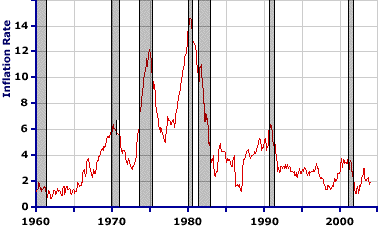
|
|
FIXED STRUCTURES: One of three types of capital goods purchased with investment expenditures. Fixed structures include buildings, factories, and other capital goods that are essentially fixed to the ground. The other types of capital are equipment and inventories.
Visit the GLOSS*arama
|
|


|

|
                           DISINFLATION: A decline in the inflation rate. With disinflation, prices continue rising, just not as fast. Numerically speaking, disinflation occurs if the inflation rate over three consecutive years is 10 percent, 6 percent this year, and 4 percent. Disinflation, a reduction in the inflation rate, is not the same as deflation, which is an actual decline in the price level. Should disinflation continue, presumably due to anti-inflationary monetary or fiscal policies, then the average price level might eventually decline, making the transition from disinflation to deflation. | Inflation Rate |  |
Disinflation generally comes into popular use when inflation has been relatively high and troublesome for a period of time and people are looking for any sign of relief. As such, a decrease in the inflation rate is taken as good news. However, disinflation is actually a relatively common phenomenon associated with business cycles. As this chart of inflation rates over the past few decades illustrates, inflation invariably declines during business-cycle contractions (shaded areas).During the contraction of the early 1990s, disinflation brought the inflation rate down from about 6 percent to just over 2 percent. An even more dramatic example of disinflation resulted from the contraction of the early 1980s. The inflation rate declined from over 14 percent to under 4 percent. In fact, this particular contraction was created with contractionary monetary policy by the Federal Reserve System with the expressed goal of reducing the high inflation rates that characterized the 1970s, that is, to achieve disinflation.

Recommended Citation:DISINFLATION, AmosWEB Encyclonomic WEB*pedia, http://www.AmosWEB.com, AmosWEB LLC, 2000-2025. [Accessed: July 18, 2025].
Check Out These Related Terms... | | | | | | | | | | |
Or For A Little Background... | | | | | | | | | |
And For Further Study... | | | | | | | | | | | | | |
Related Websites (Will Open in New Window)... | | |
Search Again?
Back to the WEB*pedia
|



|

|
BLUE PLACIDOLA
[What's This?]
Today, you are likely to spend a great deal of time searching the newspaper want ads looking to buy either a wall poster commemorating the first day of winter or blue cotton balls. Be on the lookout for rusty deck screws.
Your Complete Scope
This isn't me! What am I?
|

|
|
In his older years, Andrew Carnegie seldom carried money because he was offended by its sight and touch.
|

|
|
"A winner is someone who recognizes his God-given talents, works his tail off to develop them into skills, and uses those skills to accomplish his goals. " -- Larry Bird, basketball player
|

|
UR
Unemployment Rate
|

|
|
Tell us what you think about AmosWEB. Like what you see? Have suggestions for improvements? Let us know. Click the User Feedback link.
User Feedback
|


|


